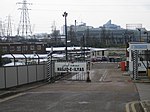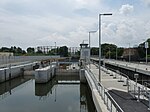Abbey Mills Pumping Station

Abbey Mills Pumping Station is a sewage pumping station in Mill Meads, East London, operated by Thames Water. The pumping station lifts sewage from the London sewerage system into the Northern Outfall Sewer and the Lee Tunnel, which both run to Beckton Sewage Treatment Works. The original pumping station, designed by engineer Joseph Bazalgette, Edmund Cooper, and architect Charles Driver, was built between 1865 and 1868, housing eight beam engines by Rothwell & Co. of Bolton. Two engines on each arm of a cruciform plan, with an elaborate Byzantine style, described as The Cathedral of Sewage. Another of Bazalgette's designs, Crossness Pumping Station, is located south of the River Thames at Crossness, at the end of the Southern Outfall Sewer. A modern sewage pumping station (Station F) was completed in 1997 about 200 metres (660 ft) south of the original station.
Excerpt from the Wikipedia article Abbey Mills Pumping Station (License: CC BY-SA 3.0, Authors, Images).Abbey Mills Pumping Station
Long Wall, London West Ham (London Borough of Newham)
Geographical coordinates (GPS) Address External links Nearby Places Show on map
Geographical coordinates (GPS)
| Latitude | Longitude |
|---|---|
| N 51.5307 ° | E -0.000835 ° |
Address
Abbey Mills Pumping Station
Long Wall
E3 3JL London, West Ham (London Borough of Newham)
England, United Kingdom
Open on Google Maps






